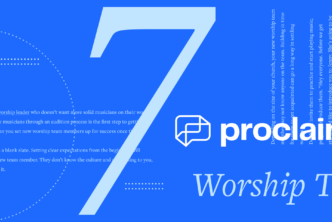Whether you’re building a church website for the first time or updating it for the tenth time, you might feel in over your head.
Indeed, there is a lot to keep in mind when it comes to building a truly great church website.
But for now, just focus on three big rules, and you’ll be much closer to a church website that’s welcoming to visitors, helpful for members, and true to your church.
1. Have a main point
It’s as true for term papers as it is for church websites: you need a thesis.
What is the one message you want to stand out? After one minute on your church website, what’s the main impression you want a potential visitor to have? “This church is ________.”
Write to that.
It may take some time to figure out what that one thing is, so write liberally. Get your staff around a whiteboard. Throw sticky notes up on the wall. Freewrite until you arrive at the main message you want to stand out.
Ask questions like:
- What one impression do we want to visitors to leave with?
- What is the one thing our church exists to do?
- What sets our church apart from others?
Follow those threads until you arrive at the main point, then make it the North Star of your website. You may be tempted to just start writing—to explain at length the history of your church, your beliefs, your mission and vision, the different ministries you have, etc.
You should explain those things, but all in relation to your main point.
That main point will determine not only the words you use but your website artwork as well.
Holy Cross Lutheran Church is a great example. Their main idea is, “Life, together in the orchard,” which is similar to other churches except for the orchard idea. The site comes around that. Their imagery, color pallet, and language give an earthy vibe, and the video (which you’ll likely watch, given its prominent placement) reinforces that with folksy music, mention of their church’s physical land (“orchard”), and unedited clips of people in the congregation (“life together”).
2. Make key information visible
The best church websites make key information easy to find without overloading a visitor with too much too soon.
It’s all about balance—and menus.
There’s no one way to organize a church website menu, but generally, you’ll see pages like:
- About Us (including Leadership, Contact, What We Believe, and Mission and Values pages)
- Visit (including details about service times, locations, and expectations)
- Ministries
- Getting Involved
- Events
- Resources (including sermons)
- Giving (including a link or form for online giving)
The Commons San Diego does a great job with its menus. Icons on the left of the page indicate a menu, and hovering over it reveals text that describes each menu option.
Menus are essential because they make it easy to browse or find specific information.
When visitors peruse a church website, they’ll be asking specific questions, and they’ll be looking for menus to find answers to:
- When and where does this church meet? (Visit)
- Does this church have ministries for my children or teens? (Ministries)
- What are their doctrinal beliefs? (What We Believe)
- Who are the pastors at this church? (Leadership)
- How is this church involved in the community? (Getting Involved)
Give careful thought to organization, and the right information will be easy to find.
3. Be straightforward
The best church websites use simple, hype-free, factual language.
One way to help yourself do this is to pretend that with every word you write, you’re speaking to your unsaved neighbor.
The great advertiser David Ogilvy suggests something similar. Replace “body copy” with “church website” and “buying a new car” with “attending church again,” and you’ve got good advice for writing your church website:
When you sit down to write your body copy, pretend that you are talking to the woman on your right at a dinner party. She has asked you, “I am thinking of buying a new car. Which would you recommend?” Write your copy as if you were answering that question.
(1) Don’t beat about the bush—go straight to the point. Avoid analogies of the “just as, so too” variety.
(2) Avoid superlatives, generalizations, and platitudes. Be specific and factual. Be enthusiastic, friendly, and memorable. Don’t be a bore. Tell the truth, but make the truth fascinating.
Speaking plainly will disarm whoever comes to your website. They’ll trust you more than if you used language that feels salesy or over-the-top.
The truth is, God is doing a great work in your church. Tell that story on your church website.
You’re living the story. Now all you have to do is put it online.





